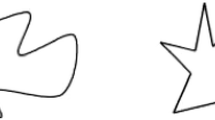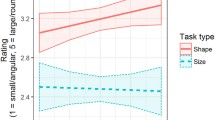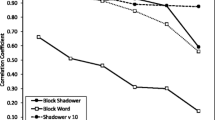Abstract
In studies of phonetic symbolism, the most commonly cited attribute of speech relevant to the phenomenon has been frequency. The present study was conducted in order to examine the relationship between pure tone frequencies and geometric figures. A pure tone oscillator was constructed which produced tones in a continuous sweep from 40–12,250 Hz. Six geometric shapes were employed and varied along three binary dimensions (size, complexity, and density) producing a total of 48 stimulus figures. Twelve male and twelve female subjects adjusted pure tone frequencies until they “best fit” the visually presented geometric figure in a complete within-subject, block-randomization design of 48 trials. There was consistency in the assignment of pure tone frequencies to the dimensions of the geometric figures. Round figures (circles and ellipses) generally received lower frequency assignments than other figures, and the shape by size interaction was also found to be statistically significant. The results are interpreted in light of recent research in psycholinguistics and in particular to the hypothesis of a “universal phonetic symbolism.”
Similar content being viewed by others
References
Brown, R. (1958).Words and Things, The Free Press of Glencoe, New York.
Brown, R. W., Black, A. H., and Horowitz, A. E. (1955). Phonetic symbolism in natural languages.J. Abnorm. and Soc. Psychol. 50:388–393.
Denes, P. B., and Pinson, E. N. (1973).The Speech Chain: The Physics and Biology of Spoken Language, Anchor Press/Doubleday, Garden City, N.Y.
Eberhardt, M. (1940). A study of phonetic symbolism in deaf children.Psychol. Monog. 52:23–41.
Gulick, W. L. (1971).Hearing: Physiology and Psychophysics, Oxford University Press, New York.
Jespersen, O. (1922).Language: Its Nature, Development, and Origin, Allen & Unwin, London.
Keppel, G. (1973).Design and Analysis: A Researcher's Handbook, Prentice-Hall, Englewood Cliffs, N.J.
Ladefoged, P. (1975).A Course in Phonetics, Harcourt Brace Jovanovich, New York.
Mol, H., and Uhlenbeck, E. M. (1954). The analysis of the phoneme in distinctive features and the process of hearing.Lingua 4:167–193.
Molino, J. A. (1973). Pure tone equal-loudness contours for standard tones of different frequencies.Percept. Psychophys. 1:1–4.
Newman, S. (1933). Further experiments in phonetic symbolism.Am. J. Psychol. 45:53–75.
Sapir, E. (1929). A study in phonetic symbolism.J. Exp. Psychol. 12:225–239.
Tarte, R. D. (1976). Phonetic symbolism for pure tones. Paper presented at the November meeting of the Psychonomic Society, St. Louis Mo.
Tarte, R. D., and Barritt, L. S. (1971). Phonetic symbolism in adult native speakers of English: Three studies.Lang. Speech 14:158–168.
Taylor, I. (1976).Introduction to Psycholinguistics, Holt, Rinehart and Winston, New York.
Taylor, I. K., and Taylor, M. M. (1962). Phonetic symbolism in four unrelated languages.Can. J. Psychol. 16:344–356.
Taylor, I. K., and Taylor, M. M. (1965). Another look at phonetic symbolism.Psychol. Bull. 64:413–427.
Author information
Authors and Affiliations
Additional information
This research was a portion of a Master's thesis submitted to the University of Nevada, Las Vegas, by Michael W. O'Boyle, who is now at the University of Southern California.
Rights and permissions
About this article
Cite this article
O'Boyle, M.W., Tarte, R.D. Implications for phonetic symbolism: The relationship between pure tones and geometric figures. J Psycholinguist Res 9, 535–544 (1980). https://doi.org/10.1007/BF01068115
Accepted:
Issue Date:
DOI: https://doi.org/10.1007/BF01068115




